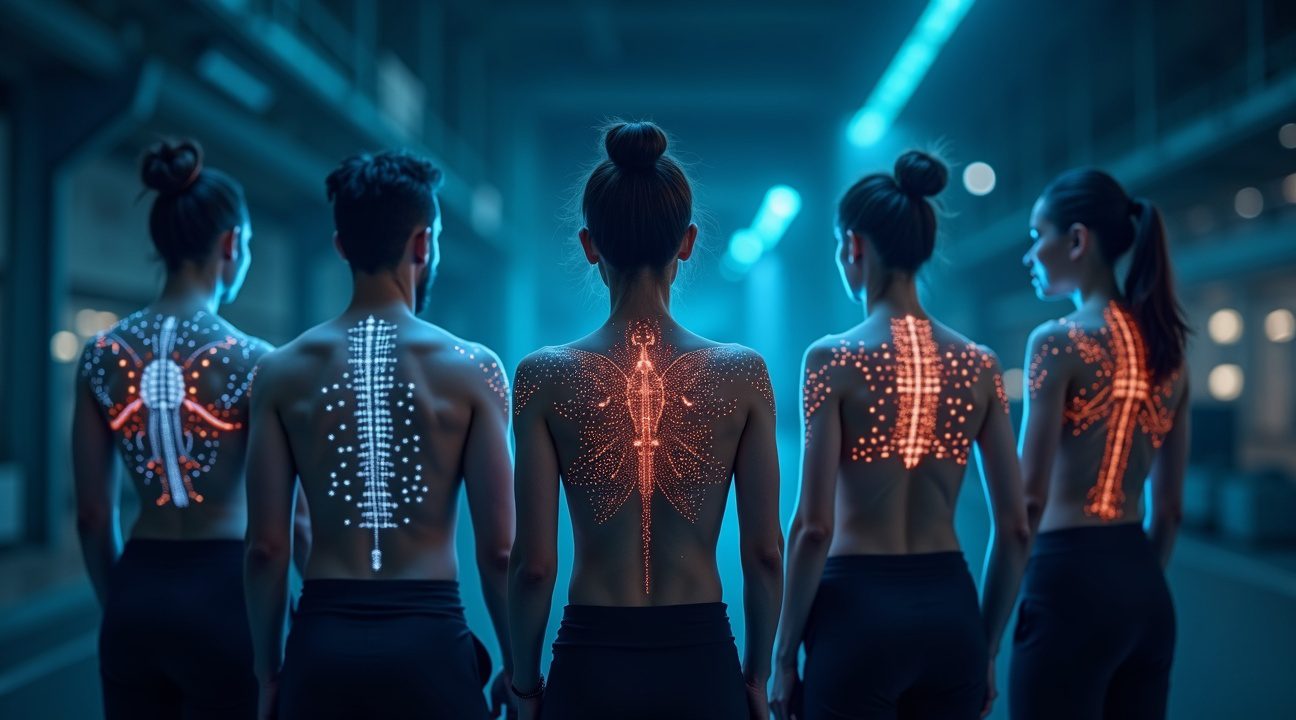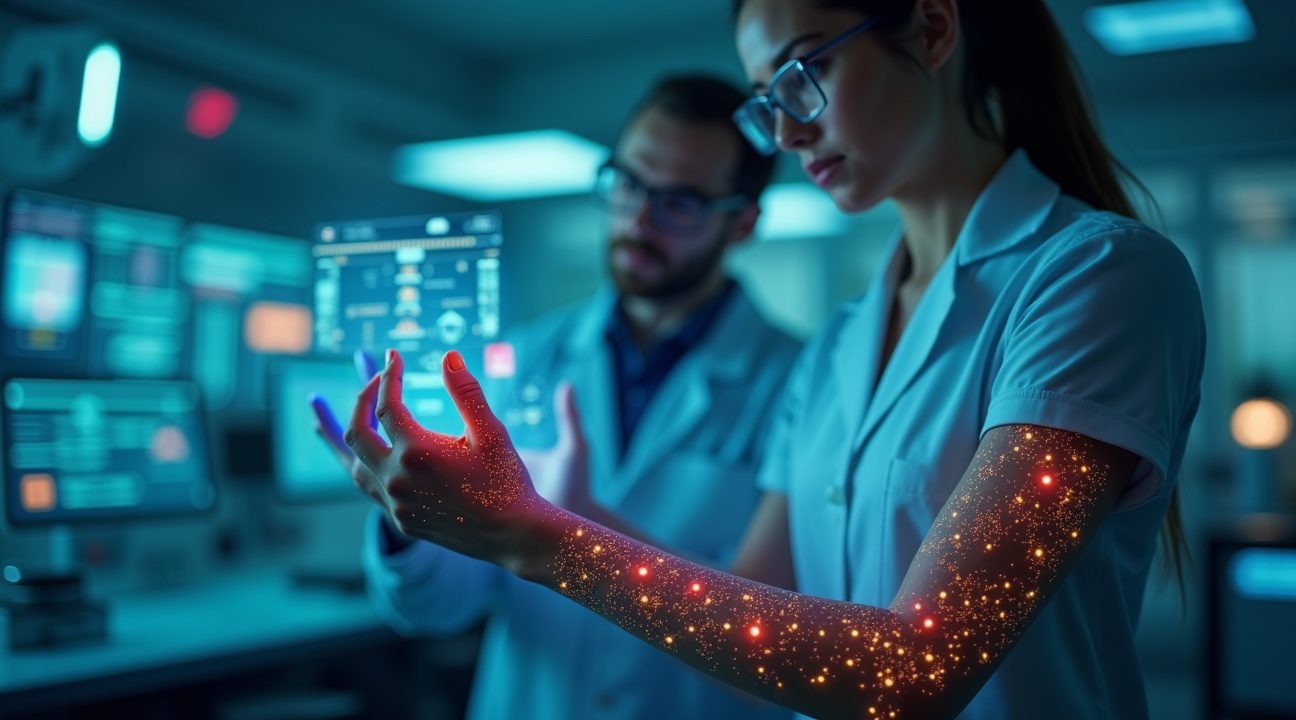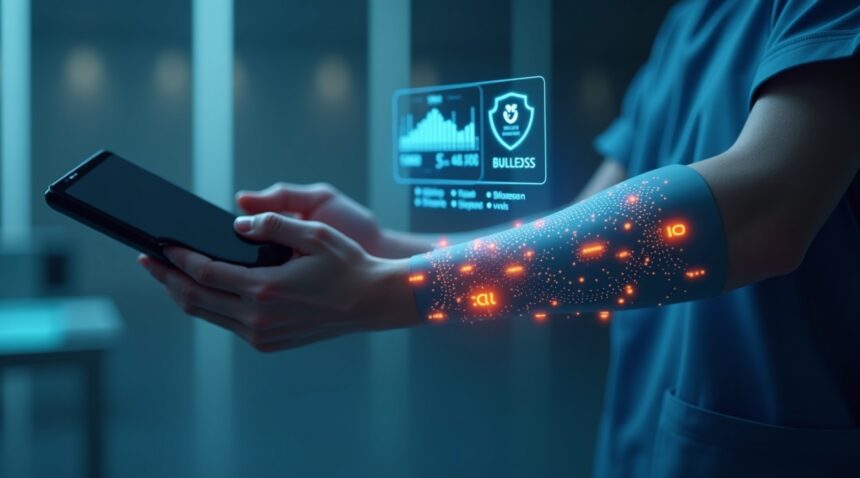Researchers worldwide are advancing the development of smart tattoos by embedding sophisticated sensors directly into temporary or permanent tattoo designs, offering a groundbreaking approach to health monitoring.
Key Takeaways
- Smart tattoos monitor multiple health metrics simultaneously including heart rate, body temperature, blood glucose levels, hydration status, and stress hormones through continuous skin contact.
- This technology uses wireless connectivity to sync real-time health data to smartphones and healthcare platforms, enabling remote patient monitoring and immediate medical interventions when abnormal readings occur.
- Advanced biosensitive inks change color to provide instant visual feedback about health status, eliminating the need for complex readouts or smartphone apps to indicate physiological changes.
- Leading institutions and companies like MIT, Harvard, and MC10 are developing both temporary and permanent versions with wide applications, ranging from diabetes management to athletic performance optimization.
- Critical challenges include cybersecurity, privacy, regulation, and standardization in terms of collecting and transmitting continuous biometric data across various platforms and manufacturers.
Applications and Future Outlook
Smart tattoos have the potential to revolutionize personal and clinical health monitoring. These ultra-thin, flexible devices offer a lighter, more seamless alternative to traditional wearables and bulky medical sensors. Unlike standard fitness trackers, which may be removed or go unused, smart tattoos adhere closely to the skin and function without user intervention.
In the clinical field, this innovation can improve the quality of life for individuals with chronic health conditions by providing up-to-date tracking and automatic alerts to healthcare providers. Athletes, too, may benefit from optimized training programs based on real-time performance and recovery data.
Further research and collaboration across academic institutions, private companies, and regulatory bodies will be essential in realizing the full potential of these devices. Privacy protection, universal design standards, and secure data storage protocols will be vital components of widespread adoption.
To learn more, visit the MC10 official website to explore one of the leaders in wearable biometric technology.
Revolutionary Skin-Based Sensors Could Replace Traditional Health Monitors
Smart tattoos represent a breakthrough in health monitoring technology that’s changing how I track vital signs throughout the day. These innovative skin-adherent devices embed sensors and digital components directly into temporary or permanent tattoos, creating a seamless interface between technology and the human body. Unlike bulky fitness trackers or traditional smartwatches, smart tattoos offer continuous, non-invasive health monitoring that feels virtually weightless on the skin.
Advanced Biometric Monitoring Capabilities
These flexible electronics pack impressive functionality into an ultra-thin design that conforms perfectly to skin contours. Smart tattoos continuously track multiple vital health metrics, delivering comprehensive health data that rivals expensive medical equipment. The monitoring capabilities include several key features:
- Heart rate variability tracking throughout daily activities
- Core body temperature fluctuations during exercise and rest
- Real-time hydration status through sweat analysis
- Blood glucose levels for diabetic management
- Stress hormone detection through skin conductivity
- Sleep quality assessment during nighttime hours
What sets these devices apart from conventional wearables is their ability to maintain consistent skin contact without causing discomfort or irritation. The sensors remain functional for 24 hours or more, withstanding sweat, water exposure, and normal daily activities. This durability makes them ideal for athletes, medical patients, or anyone requiring constant health surveillance.
Wireless Connectivity and Real-Time Data Sync
Smart tattoos leverage wireless connectivity to sync collected data instantly to smartphones or cloud platforms, enabling healthcare providers to monitor patients remotely. This real-time data transmission supports immediate healthcare interventions when abnormal readings occur. Advanced AI algorithms analyze patterns in the collected biometric data, identifying potential health issues before they become serious problems.
Healthcare professionals can access patient data from anywhere, making telemedicine consultations more effective and comprehensive. The wireless health data transmission eliminates the need for frequent office visits while maintaining continuous medical oversight. Emergency alerts automatically trigger when critical thresholds are exceeded, potentially saving lives through rapid response protocols.
The customizable designs appeal to diverse user groups by combining functionality with personal aesthetic preferences. Users can choose from various tattoo styles that match their individual tastes while maintaining full monitoring capabilities. This personalization factor significantly increases user adoption rates compared to generic medical devices.
Smart tattoos also excel in specialized applications where traditional wearables fall short. Military personnel benefit from covert health monitoring during missions, while elderly patients appreciate the hands-free operation that doesn’t require charging or maintenance. Athletes use these skin-based sensors to optimize training regimens through precise biometric feedback during intense workouts.
The technology’s potential extends beyond individual health tracking into population health studies and clinical research. Researchers can gather large-scale health data from willing participants without disrupting their daily routines. This passive data collection provides valuable insights into disease patterns, treatment effectiveness, and preventive care strategies.
Manufacturing costs continue to decrease as production scales increase, making smart tattoos more accessible to broader populations. The skin interface technology eliminates many mechanical components found in traditional wearables, reducing complexity and potential failure points. Future iterations promise even longer wear times and expanded monitoring capabilities as flexible electronics continue advancing.
Healthcare systems worldwide are exploring integration possibilities for smart tattoos in routine patient care. These wearable sensors offer unprecedented monitoring capabilities that could revolutionize preventive medicine and chronic disease management. The combination of comfort, functionality, and aesthetic appeal positions smart tattoos as serious contenders to replace many traditional health monitoring devices in the coming years.
Game-Changing Medical Applications Transform Chronic Disease Management
Smart tattoos represent a revolutionary shift in how I can monitor my health, offering continuous surveillance that eliminates many traditional barriers to effective disease management. These innovative devices integrate seamlessly with the skin, providing real-time data collection that surpasses conventional monitoring methods.
For diabetes management, smart tattoos track glucose levels through interstitial fluid analysis, completely removing the need for painful finger-pricking multiple times daily. The technology connects to smartphone apps that deliver instant alerts when glucose levels fluctuate outside normal ranges, enabling immediate dietary or medication adjustments. This advancement transforms diabetes care from reactive to proactive management.
Cardiovascular and Performance Monitoring Applications
Cardiovascular health receives continuous assessment through ECG and EMG signal monitoring embedded within the tattoo matrix. These sensors detect irregular heart rhythms, arrhythmias, or other cardiac abnormalities before symptoms manifest. The constant data stream helps identify patterns that might indicate developing cardiovascular issues, supporting early intervention strategies that can prevent serious complications.
Smart tattoos excel at tracking multiple biomarkers simultaneously, including:
- Cortisol levels for stress management and mental health monitoring
- Electrolyte balance for proper hydration assessment
- Muscle activity patterns for athletic performance optimization
- Heart rate variability for cardiovascular fitness evaluation
- Temperature regulation for fever detection or heat stroke prevention
Athletic performance optimization benefits significantly from muscle activity tracking and hydration monitoring capabilities. These tattoos detect early signs of muscle fatigue or dehydration that could lead to injuries during training or competition. Athletes can adjust their routines based on real-time feedback, maximizing performance while minimizing injury risk.
High-risk industries are exploring workplace safety applications where smart tattoos monitor alertness levels and stress indicators. Construction workers or aviation professionals could receive warnings when fatigue or stress reaches dangerous thresholds, potentially preventing accidents caused by human error. Much like how artificial intelligence enhances safety protocols, these tattoos provide continuous oversight of worker wellbeing.
Remote patient monitoring represents perhaps the most transformative application, enabling clinicians to access live health data from patients anywhere. This capability reduces hospital visits, lowers healthcare costs, and enables rapid intervention when health parameters shift unexpectedly. Elderly patients or those with chronic conditions benefit from constant supervision without sacrificing independence or quality of life.
The integration with telemedicine platforms creates comprehensive healthcare ecosystems where doctors can monitor multiple patients simultaneously, receiving automated alerts when any individual requires attention. This system proves particularly valuable for managing chronic diseases that require consistent monitoring but don’t always necessitate in-person visits.

Breakthrough Technology Built on Decade of Scientific Innovation
Artificial intelligence paving the way for advanced health monitoring has found an unexpected canvas in human skin itself. Smart tattoos represent the culmination of years of interdisciplinary collaboration, bringing together experts from materials science, bioengineering, electronics, and dermatology to create something truly revolutionary.
John Rogers’ lab at the University of Illinois marked a pivotal moment in 2011 when researchers first successfully demonstrated flexible skin-mounted electronic tattoo technology. This breakthrough opened doors to possibilities that seemed like science fiction just a decade earlier. The initial research focused on creating ultra-thin electronic devices that could conform to skin’s natural movements without breaking or causing discomfort.
The field gained significant momentum by 2015 when the first electronic temporary tattoos became publicly available. These early versions proved that the concept wasn’t just laboratory fantasy—real people could wear functional electronic devices directly on their skin for extended periods.
Color-Changing Visual Health Indicators
Modern smart tattoos incorporate biosensitive ink that creates immediate visual feedback about the wearer’s health status. This color-changing technology responds to fluctuations in glucose levels, sodium concentration, pH balance, and hydration status. This is particularly fascinating because it eliminates the need for complex readouts or smartphone apps—the tattoo itself becomes a direct visual indicator of physiological changes.
The colorimetric ink technology works by incorporating biosensors that trigger chemical reactions when exposed to specific biomarkers in sweat or interstitial fluid. When glucose levels spike, for instance, the tattoo might shift from blue to red, providing instant awareness of diabetic episodes without the need for traditional blood glucose meters.
Advanced Materials Enhance Performance
Graphene and specialized nanomaterials have transformed what’s possible with electronic tattoos. These materials deliver exceptional conductivity while maintaining the flexibility needed for comfortable wear on human skin. Graphene nanosheets, in particular, have revolutionized signal quality for applications like electrocardiograms and surface electromyography (sEMG) monitoring.
The integration of these advanced materials allows smart tattoos to capture muscle activity with remarkable precision. Athletes can monitor muscle performance during training, while medical patients can track recovery progress after injuries or surgeries. The enhanced signal quality means healthcare providers receive more accurate data for diagnosis and treatment planning.
Some cutting-edge designs go beyond monitoring by incorporating therapeutic elements:
- Embedded heaters for targeted warming therapy
- Electrical stimulators for muscle stimulation
- Tiny drug delivery systems for real-time medication release
These therapeutic features represent a significant leap forward from simple monitoring devices. Smartwatch health monitoring has shown us the value of continuous physiological tracking, but smart tattoos take this concept to an entirely new level of integration and functionality.
The drug delivery applications hold particular promise for chronic condition management. Diabetic patients could potentially receive insulin doses automatically based on real-time glucose readings, while pain management patients might receive medication precisely when and where it’s needed most.
Research continues to push boundaries in materials science and bioengineering. Scientists are developing biodegradable options that dissolve harmlessly after predetermined periods, eliminating the need for removal procedures. Others focus on improving the longevity of permanent electronic tattoos, ensuring they continue functioning accurately for years rather than weeks.
The convergence of multiple scientific disciplines has created possibilities that individual fields couldn’t achieve alone:
- Electronics engineers provide the circuitry expertise
- Materials scientists develop the flexible substrates
- Bioengineers ensure biocompatibility
- Dermatologists offer insights on skin physiology and safety
This interdisciplinary synergy exemplifies how innovation in health technology flourishes through collaborative effort across diverse areas of expertise.

Leading Companies and Research Teams Drive Market Expansion
The global smart tattoo market continues expanding rapidly as companies and research institutions push forward with breakthrough innovations. This growth stems from increasing demand for personalized medicine solutions and consumer preferences for integrated health monitoring that doesn’t require bulky devices. Several factors drive this market expansion, including the non-invasive nature of smart tattoos, their discrete appearance, continuous monitoring capabilities, and seamless integration with mobile devices.
Industry Leaders and Research Pioneers
MC10 stands at the forefront of this technological revolution, developing advanced wearable patches that track multiple health metrics simultaneously. Their glucose monitoring systems represent significant progress in making diabetes management more convenient and less intrusive. Similarly, Sugar has created smart tattoo prototypes specifically focused on continuous glucose monitoring, offering diabetics a revolutionary alternative to traditional finger-stick testing methods.
MIT and Microsoft Research collaborated on DuoSkin, a publicly available fabrication process that enables creation of interactive, conductive temporary tattoos. These designs incorporate digital controls and color-change displays, making health monitoring both functional and aesthetically appealing. What sets DuoSkin apart is its accessibility — researchers published their fabrication methods, allowing broader experimentation and development.
Harvard and MIT’s Dermal Abyss project pushes boundaries even further with ink-based biosensors designed for both permanent and temporary tattoo applications. Their innovative ink changes color based on glucose levels, sodium concentrations, or pH fluctuations, tested successfully on pig skin. This color-changing technology could transform how people visualize their health data in real time.
Electronic Tattoo (E-Tattoo) technology integrates soft, flexible electrodes that monitor surface electromyography with accuracy comparable to commercial sensors. These ultra-thin devices conform perfectly to skin, providing continuous muscle activity monitoring without the discomfort of traditional electrode attachments.
The convergence of these innovations demonstrates how artificial intelligence is advancing healthcare monitoring. Smart tattoos represent more than just technological novelty — they’re reshaping how medical professionals and patients approach continuous health surveillance. As research teams refine their techniques and overcome regulatory challenges, the market shows strong potential for sustained growth driven by consumer demand for personalized, non-invasive diagnostic solutions.
Critical Challenges and Ethical Considerations Shape Future Development
Smart tattoos face significant technological hurdles that developers must overcome before widespread adoption becomes feasible. Standardization remains a primary concern, as different manufacturers may develop incompatible systems that limit interoperability between devices and healthcare platforms. Cybersecurity poses another substantial challenge, since these devices collect continuous streams of sensitive biological data that hackers could potentially exploit. The regulatory approval process adds complexity, requiring extensive clinical trials to demonstrate both safety and efficacy before medical device standards agencies will approve these technologies for public use.
Privacy concerns have sparked intense debate among experts who worry about potential misuse of the vast amounts of biometric data these tattoos would collect. Workplace surveillance represents one particularly troubling scenario, where employers might pressure workers to accept monitoring that extends far beyond occupational health requirements. Smartwatch technology already raises similar privacy questions, but smart tattoos would create even more intimate data profiles. Mental health monitoring capabilities could expose deeply personal information about stress levels, emotional states, and psychological patterns that users never intended to share.
Balancing Innovation with Responsible Development
Bioethics experts emphasize that responsible deployment requires interdisciplinary oversight involving technologists, medical professionals, ethicists, and legal experts working together. This collaborative approach helps balance the tremendous consumer benefits these devices could provide against legitimate concerns about data security and user consent. Regulatory compliance frameworks must evolve to address the unique challenges smart tattoos present, since existing medical device approval processes weren’t designed for permanently embedded, continuously monitoring systems.
I believe establishing clear protocols for data ownership, storage limitations, and user control will prove essential for building public trust. Users need guarantees that they retain ultimate authority over their biological data and can revoke access or request deletion at any time. Healthcare providers and technology companies must demonstrate transparent practices regarding how they collect, analyze, and share this information.
Future directions for smart tattoo technology extend far beyond basic health monitoring into exciting new territories. Integration with artificial intelligence systems could enable more sophisticated diagnostics that detect subtle patterns humans might miss. These AI diagnostics could identify early warning signs of diseases, predict health episodes before they occur, and recommend personalized treatment adjustments in real time.
Expansion beyond medical applications opens possibilities for interactive digital interfaces that turn the human body into a control surface for technology. Users might tap their tattooed skin to answer phone calls, adjust smart home settings, or interact with augmented reality environments. Smart glasses technology could work seamlessly with these tattoos to create immersive digital experiences that respond to both visual cues and biological signals.
The convergence of these technologies suggests a future where the boundary between human biology and digital systems becomes increasingly blurred. However, this transformation must occur thoughtfully, with robust safeguards protecting individual autonomy and preventing technological overreach. Success depends on maintaining human agency while harnessing the powerful capabilities these innovations offer.
Implementation timelines remain uncertain, but early prototypes demonstrate promising capabilities that could revolutionize how we monitor health and interact with technology. The path forward requires careful navigation of technical challenges while addressing legitimate ethical concerns through inclusive dialogue and comprehensive regulatory frameworks that protect users without stifling beneficial innovation.
Sources:
Meegle – “Wearable Tech Smart Tattoos”
Technowize – “Smart Tattoo Sensors: Skin Tech Changing Wearables”
Introspective Market Research – “Smart Tattoo Market”
National Center for Biotechnology Information (NCBI) – Article PMC9876543
Chuwi – “Smart Tattoos Glucose Monitoring”
Proceedings of the National Academy of Sciences (PNAS) – Article 2104686118
Harvard Gazette – “Harvard Researchers Help Develop Smart Tattoos”
Business Standard – “Working Hard? This Smart Tattoo on Forehead Could Soon Let Your Boss Know”
TEDxMileHigh – “The Rise of Smart Tattoos”


